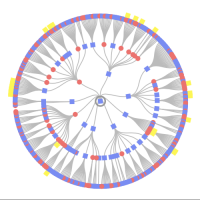Show me the size of the tree I am working on
Comments
-
gasmodels said: No there is not way you can determine the sized of the tree. The small trees are much easier to locate. For example see --- William Black Deceased • MKPC-J2W which is a tree of two. A husband and spouse with no other connections. It probably needs to be merged with another record but has not at this time.0
-
Gordon Collett said: What does the person's seven generation fan chart look like? If any of the branches reach into colonial North America or Europe, that person is certain to be in the big tree.
Those millions of small tree are mainly records created through the extraction and indexing programs that have put tiny trees consisting of a single child and his or her parents. These all need to be properly merged in. Currently I am working through the Stord, Hordaland, Norway parish records one line at a time, finding all the extraction records and duplicates for each and merging them in to families. By the time I have done what I can, thousands of these small trees will be assembled into one big tree which I'm sure will be thoroughly connect into the main tree because of others' research that has connected some of these lines into the main tree.0 -
JT said: Alan, I think you have a good idea. The problem is that FamilySearch has been refusing so far to define the limitations around what they would want to define as "Your Tree", or "Their Tree", because they prefer to be known as just one global family tree for the whole world.
I would suggest you add a suggestion as to how many generations back, down, sideways, diagonally, etc you would want to see as the definition of the "sub-tree" of that person.
One way FamilySearch has already defined (unbeknownst to them) the size of any sub-tree, is to only go back 15 generations in any one direction. Because when you click on a "View My Relationship" button for somebody you have determined is more than 15 generations back from you, it will say "no relationship found". This is because they have given a limitation on the computer software systems to avoid tying up their processing power whenever a person clicks that button, so that it responds in seemingly insignificant time.
I would agree with their 15 generations limit, but there are more parameters needed to limit the "sub-tree" size such as how far down from each direct-line relative and their siblings the counter should keep going to accumulate a number. Even if they did, many people wouldn't be able to fathom what the number it comes up with would mean, and then they would want a listing to show how the count was achieved.
Generally too messy for just the interested inquisitive mind.0 -
For surname studies I have a similar need to efficiently and effectively find and evaluate subtrees. Those subtrees are direct line ancestor and descendant trees, optionally pruned to include only bearers of a given surname.
Currently I find subtrees "by hand", which is a chore and the set is very incomplete.
Once I find subtrees I use Puzzilla graphs to get their approximate sizes, but it is wasteful of computing resources to draw tree graphs when all I want is statistics.
I need to find PIDs that don't have a single couple as parents.
I especially need to find PIDs with a surname of interest that have 0 parents; those PIDs are the heads of subtrees, where research will lead to joining them to another subtree in my study.
Various statistics exist for trees (aka rooted connected graphs). An ancestry tree that consists of a chain of son to father relationships (John Smith son of Jake Smith son of Jeff Smith son of . . .) has a branching value of 1. I have several of these in my main surname study. An ancestry tree with 2 parents for each person has a branching value of 2. An ancestry tree with legacy disputes can have a branching value greater than 2.
0 -
Continuing...
My concern is not "my" tree. My concern is I need a more efficient and effective way to scoop up all those small fragment trees. The 1-, 2-, 3- node trees are pretty easy because I can almost see from Find search results that they are that size. But the large family fragments give me fits, because in search results I see the tree listed once for each member and I have to pick out the head. That is an easy computing task but a strain on my brain.
Working with very rare surnames, it is tiring but not hard to generate a list of fragment trees by hand, but when getting into common surnames (which is where everyone needs the most help, right?) it becomes overwhelming.
(Readers, if you agree please upvote this discussion.)
0
